Choosing between mace and a stun gun for safety depends on your preferences and circumstances. Mace offers distance protection by causing temporary blindness and irritation, making it great for avoiding close contact. It’s easy to carry but requires accuracy. On the other hand, stun guns demand proximity but provide quick immobilization. They often come with safety features and built-in flashlights. Legal rules for both vary, so check local laws first. Consider portability: mace is lightweight while stun guns may need holsters. Costs differ, with mace being cheaper upfront. Each tool fits specific scenarios, revealing more nuances as you explore.
Key Takeaways
- Mace offers long-distance defense with temporary incapacitation, while stun guns require close contact for immediate immobilization.
- Local laws vary, affecting the legality of owning and using mace and stun guns for self-defense.
- Mace is compact and lightweight, fitting easily in small bags for quick deployment without close contact.
- Stun guns offer dual functions, often including flashlights, and require regular maintenance for reliability.
- Mace is generally cheaper upfront, but stun guns provide long-term savings due to reusability and rechargeable options.
Understanding Mace
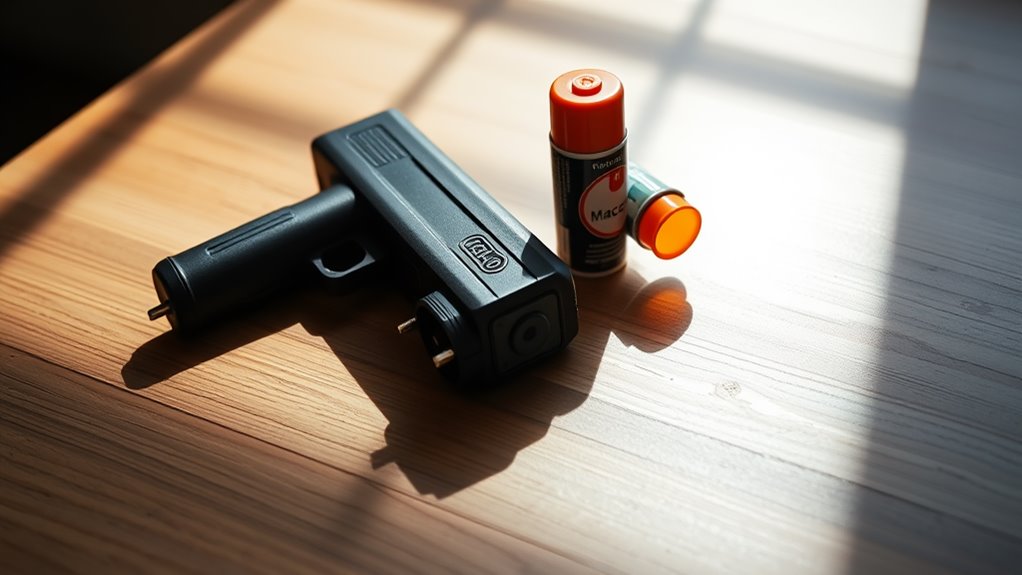
When considering personal safety options, understanding mace is essential. Mace has a storied history as a self-defense tool. Initially developed in the 1960s, it was designed to provide a non-lethal means of personal protection. Back then, mace referred to a chemical compound known as CN tear gas, which was effective but had limitations. Over time, the formula evolved, shifting towards the safer and more effective OC (oleoresin capsicum) spray, commonly associated with modern mace. The compact design of Mace keychain pepper spray allows for easy carrying and discreet storage. Knowing its applications can empower you to make informed decisions. Mace is typically used to incapacitate an attacker temporarily, allowing you time to escape. It works by causing intense irritation to the eyes, skin, and respiratory system. This effect can be vital in situations where you need to deter an aggressor quickly. It’s portable, easy to use, and can be carried discreetly in a purse or pocket, making it a popular choice for many. However, it’s important to understand the laws regarding its use in your area, as regulations can vary. By understanding mace’s history and applications, you can better prepare yourself for potential threats. Pepper sprays like the Pepper Shot 1.2% MC offer a powerful defense mechanism by causing temporary blindness and severe respiratory distress.
Exploring Stun Guns
While mace offers a reliable way to deter an attacker, stun guns provide another effective option for personal safety. If you’re considering a stun gun, it’s crucial to understand the various stun gun types and their specific features.
Compact stun guns are small and easy to conceal, making them ideal for quick access. Baton stun guns, on the other hand, combine the functions of a regular baton with the added shock capability, offering extended reach and versatility.
When evaluating stun gun features, look for voltage strength, which determines the intensity of the electrical discharge. Higher voltage typically means a more powerful shock, capable of immobilizing an attacker more effectively. The Rechargeable Tactical BashLite 85M Volt Stun Gun Flashlight is an example of a high-voltage option available in the market.
Some stun guns also come with built-in flashlights, providing dual functionality. This feature can help illuminate your path and temporarily blind an attacker, giving you an advantage.
Additionally, consider the design and grip. A stun gun with an ergonomic design guarantees a comfortable hold, reducing the risk of dropping it in stressful situations.
Safety switches are another critical feature, preventing accidental discharge. By understanding these stun gun types and features, you can make an informed decision that best suits your personal safety needs. The Bouncer Stun gun is an example of a powerful option with additional features like a flashlight and glass breaker for enhanced utility.
Comparing Effectiveness
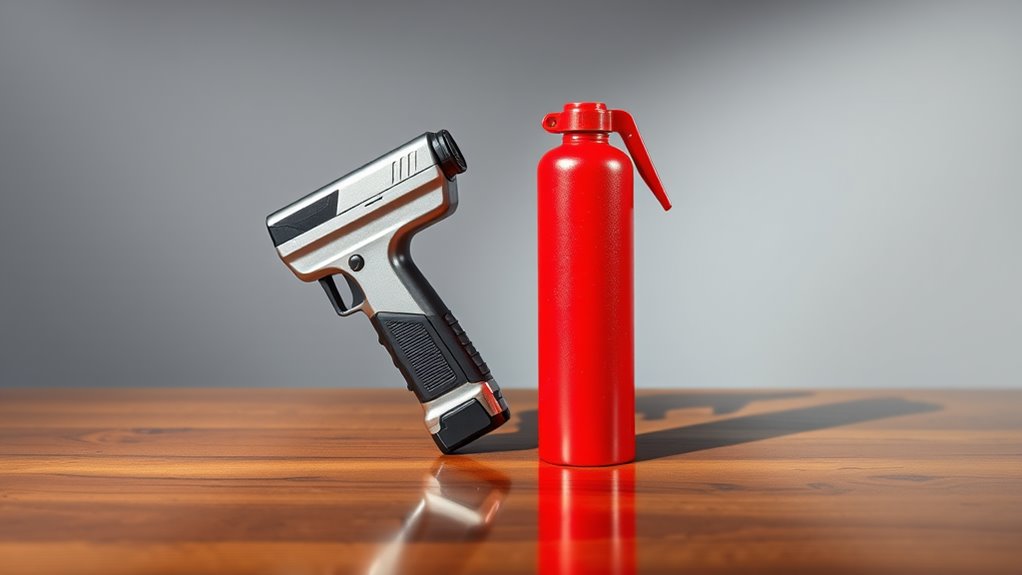
Effectiveness matters when considering self-defense tools like mace and stun guns. When you’re deciding which to carry, it’s essential to think about how they’ll perform in real life scenarios.
Mace, known for its ability to incapacitate an assailant by causing temporary blindness and difficulty breathing, has been praised in user experiences for its ability to create a safe escape route. Many users appreciate its ability to work from a distance, allowing you to maintain space between yourself and a potential threat. Additionally, the Mace Pepper Spray Jogger offers versatility in carry options, such as a key-chain or Velcro-like strap, making it ideal for sports and outdoor activities.
On the other hand, stun guns require close contact but pack a powerful punch. In real life scenarios, users report feeling more in control when they’ve a stun gun since it can quickly immobilize an attacker, giving you precious seconds to flee.
However, these devices demand proximity, which could be a disadvantage if you’re not comfortable with such close encounters.
When comparing effectiveness, think about your comfort level and likelihood of needing each tool. User experiences highlight that mace is often favored for its ease in creating distance, while stun guns excel in immediate, close-contact situations.
Ultimately, understanding your own comfort and typical environments will guide your choice.
Ease of Use
Choosing between mace and a stun gun often comes down to their ease of use, which can vary considerably.
Picture yourself in different user scenarios. With mace, you aim and spray, guaranteeing the substance reaches your target. It requires minimal user training, but accuracy is key, especially in stressful situations. You must guarantee the wind doesn’t blow the spray back towards you, which could complicate things.
On the other hand, stun guns require close contact. You need to be within arm’s reach of the assailant to effectively deploy the electric charge. This proximity can be a disadvantage if you’re uncomfortable with confrontation.
However, it doesn’t need precision in the same way mace does, as contact with any part of the body is often enough. Some stun guns come with built-in safety features to prevent accidental discharge, which might require a bit of user training to familiarize yourself with.
Ultimately, your choice may depend on what feels more intuitive in potential user scenarios you could face. Consider how much user training you’re willing to undergo, and which method you feel you can confidently and safely use under pressure.
Legal Considerations
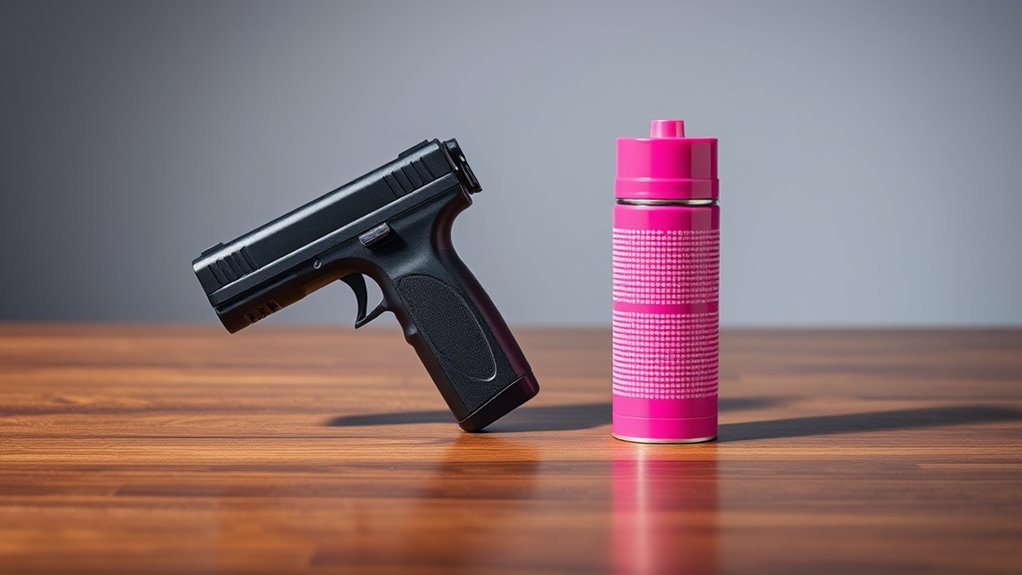
When it comes to legal considerations, you must be aware of the regulations surrounding the use of mace and stun guns in your area. Self defense laws vary considerably, and it’s essential to understand state regulations that apply to your situation. Some states might’ve strict rules about owning and using these devices, while others could be more lenient.
Local ordinances might impose additional restrictions, so it’s wise to check with local authorities for specific guidelines.
Consider the use cases for both mace and stun guns. Depending on where you live, one might be favored over the other based on legal consequences. For instance, some places classify stun guns as firearms, which could complicate your defense strategy if used improperly.
Liability issues should also be considered; using these devices improperly might result in civil or criminal liabilities.
Training requirements are another factor to think about. Some states mandate training courses before you can legally carry or use a stun gun. Age restrictions are also common, often requiring users to be 18 or older.
Portability and Accessibility
For those considering self-defense options, portability and accessibility are essential factors to weigh. You want a tool that’s easy to carry and ready for action in unpredictable situations. Mace and stun guns offer distinct advantages in these areas, but which suits you better?
When evaluating weight considerations, Mace typically takes the lead. It’s compact and lightweight, often fitting comfortably in a pocket or small purse. This makes it an excellent choice for quick access in self-defense scenarios, especially if you’re on the move. Its size guarantees that you won’t feel burdened during your daily routine.
On the other hand, stun guns can vary in size and weight. While some models are designed to be compact, others may feel bulkier, which could affect how you carry them. However, stun guns often come with holsters or clips, providing different carrying options that could enhance accessibility when an urgent situation arises.
Ultimately, your choice between Mace and a stun gun will depend on your specific needs and lifestyle. Consider where you’ll carry it and how seamlessly it integrates into your daily routine, guaranteeing you’re prepared for any self-defense scenario.
Maintenance and Durability
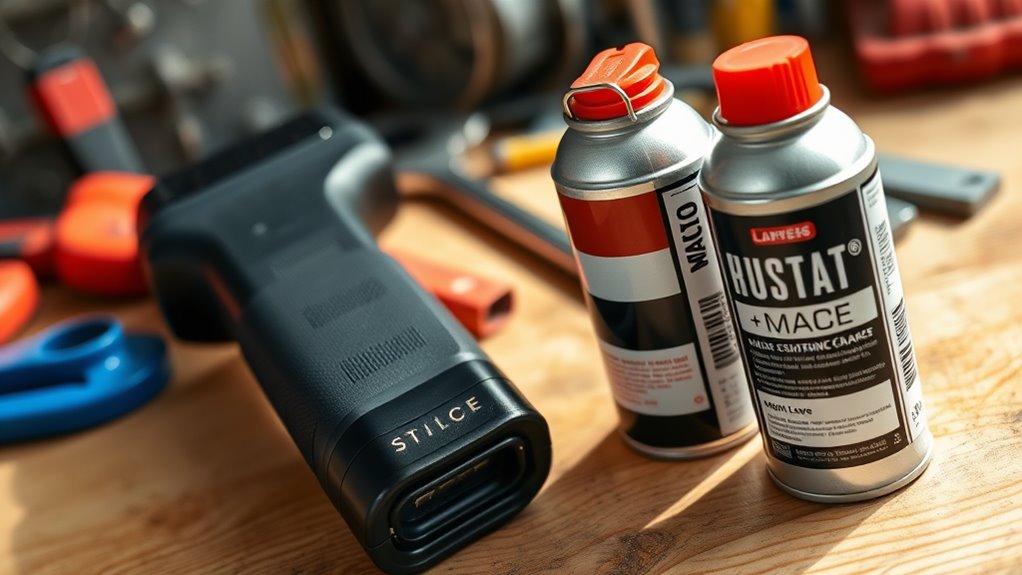
Evaluating maintenance and durability is vital when selecting a self-defense tool. When you consider mace, you’ll find it requires minimal upkeep. Simply store it in a cool, dry place and check the expiration date regularly. Mace typically has a decent lifespan, often ranging from two to four years, depending on the brand. Once it’s past its expiration, it’s time to replace it to guarantee effectiveness.
Stun guns, on the other hand, demand a bit more attention. Cleaning techniques for stun guns involve wiping the exterior with a dry cloth to remove dirt and moisture. It’s important to regularly inspect the electrodes for corrosion, making sure they perform efficiently.
You’ll also need to recharge or replace the batteries periodically, as a fully charged stun gun is essential for reliable performance. In terms of lifespan expectations, stun guns can last several years if well-maintained; however, the lifespan may vary based on usage frequency and battery care.
Cost Comparison
After considering maintenance and durability, it’s also important to weigh the financial aspects of choosing between mace and stun guns.
Mace, often more affordable initially, typically costs between $10 to $50. However, the price variations can be notable depending on the brand, size, and formula strength.
On the other hand, stun guns generally have a higher upfront cost, ranging from $20 to $100 or more, reflecting differences in voltage, features, and design.
When evaluating long term investment, consider how often you’ll need to replace or recharge your chosen tool. Mace cans may require regular replacement, especially after use or once expired, which can add up over time.
Conversely, investing in a stun gun might require a higher initial expense, but it often proves more economical in the long run as it can be recharged and reused multiple times.
Additionally, factor in potential accessory costs. Mace may require cases for safe carrying, while stun guns might need holsters or additional chargers.
Ultimately, understanding these price variations and considering the long term investment can guide you in making a cost-effective decision for your personal safety needs.
Choosing the Right Tool
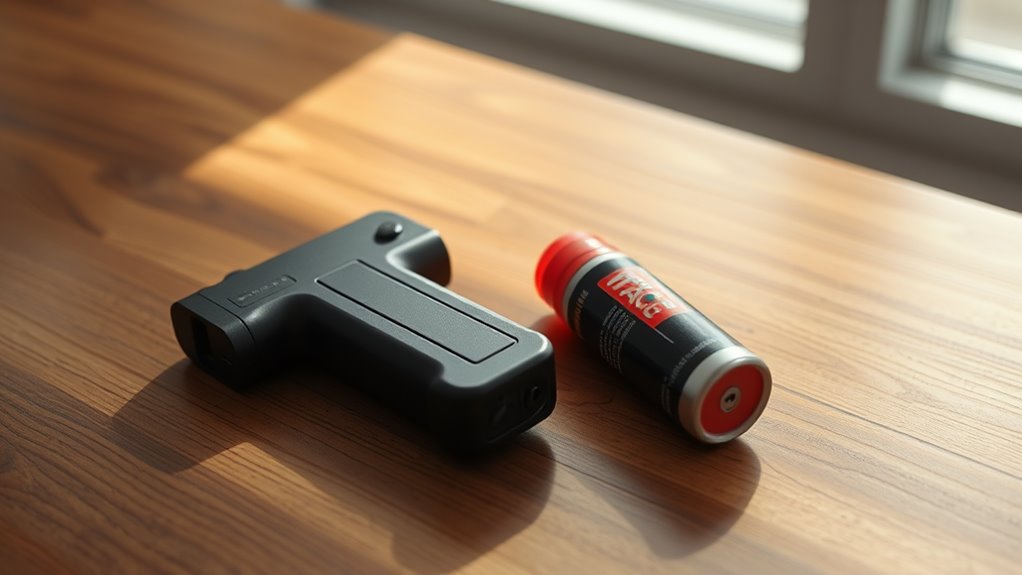
When selecting the right tool for personal safety, it’s vital to take into account both your lifestyle and specific needs. Your environment and daily activities play a significant role in your choice between mace and a stun gun. If you’re often out jogging or walking alone, a compact and lightweight mace can be easily carried and quickly accessed. It’s effective for deterring potential threats at a distance, aligning with proactive self defense strategies.
On the other hand, if you frequently find yourself in close-contact situations or confined spaces, a stun gun might be more suitable. It gives you the advantage of incapacitating an assailant with direct contact, which could be necessary in tight quarters.
Consider your comfort level with each tool and practice using them to guarantee your personal safety is enhanced rather than hindered. Additionally, think about the legal regulations in your area. Some places impose restrictions on stun guns or mace, impacting your decision.
It’s also important to evaluate how each tool fits into your broader self defense strategies. Training and familiarity can boost your confidence in using either option effectively. Ultimately, your choice should empower you to feel safer and more secure in your daily life.
Frequently Asked Questions
Are There Any Age Restrictions for Purchasing Mace or Stun Guns?
You might face age limitations when buying mace or stun guns. Legal requirements vary by state, often mandating buyers to be at least 18. Always check your local laws to verify compliance and avoid potential penalties.
How Do Mace and Stun Guns Affect People With Pre-Existing Health Conditions?
Imagine a heart patient collapsing after exposure. Mace or stun guns can worsen pre-existing health conditions. Always seek medical advice before considering their use, ensuring you’re protecting yourself without risking others’ health. Stay informed and cautious.
Can Mace or Stun Guns Be Used in Self-Defense Against Animals?
You can use mace and stun guns against aggressive animals. Understanding animal behavior helps in choosing the most effective deterrent. Make certain you’re trained, as improper use might not deter the animal and could escalate situations.
What Are the Potential Psychological Effects of Using Mace or Stun Guns?
Imagine wielding a double-edged sword. When you use mace or a stun gun, your fear response heightens. You might grapple with moral implications, questioning if causing harm was justified, affecting your psyche long after the encounter.
How Does Climate or Weather Affect the Performance of Mace and Stun Guns?
You’ll notice temperature effects can reduce a stun gun’s battery life. Mace’s effectiveness decreases in windy or humid conditions, as the spray might disperse quickly or become less potent. Always consider weather before using either device.




